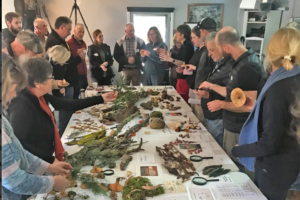Alison Pouliot

The so-called “shroom boom” is here and interest in fungi is growing rapidly, especially among the foraging community. But beyond edible mushrooms, fungi provide the fundamental soil architecture that holds terrestrial ecosystems together. Be they forests, woodlands or agroecosystems, fungi provide the scaffold of processes and connectivities that underpin soil health.
Since running my first fungus workshop twenty years ago, it has been exciting to witness the exponential increase in interest in fungi; including forayers, foragers, farmers, horticulturalists, conservationists and people from all walks of life. It seems that fungi are finally being recognised as a vital part of our concepts of nature, biodiversity and conservation, but also as fundamental to the success of agroecosystems.
Hence I was delighted to run a series of workshops recently in the Southern Tablelands of NSW, specifically for farmers to explore the role of fungi in soil health. While traditional views about soil considered their physical factors with little regard for soil biology, thinking is changing with the complex networks of fungus, animal and plant associations taking a much greater focus. Sustainable and regenerative agriculture is very much about understanding these interactions, the processes of nutrient cycling and recognising these underground organisms as the drivers of bio-productivity.
By minimising soil compaction, conducting intensive rotational grazing, reducing tilling, as well as growing cover crops and intercropping, farmers are encouraging the return of fungi in agricultural soils. Consequently they are enjoying reduced fertiliser and irrigation costs as well as increasing the nutrient integrity of their crops. Restoring soil biodiversity also sequesters carbon in soil, a key aspect to slowing climate change.
Regenerative farmer, Gill Sanbrook, who hosted one of the workshops at her property, Bibbaringa, on the south west slopes of NSW, strives to maximise the biodiversity in her farm soils, including fungi. Gill has radically reduced the use of chemical fertilisers, pesticides and fungicides through farming practices based on the available resources and her efforts to minimise soil compaction and disturbance, thus encouraging a return of soil fungi.
Further workshops exploring the role of fungi in soil health, carbon sequestration, water retention and regenerative agriculture will run in autumn 2020. More information: alisonpouliot.com

